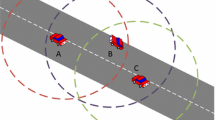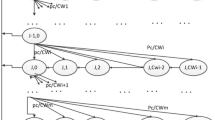Abstract
The IEEE 802.11 MAC protocol provides shared access to a wireless channel. This paper uses an analytic model to study the channel capacity – i.e., maximum throughput – when using the basic access (two-way handshaking) method in this protocol. It provides closed-form approximations for the probability of collision p, the maximum throughput S and the limit on the number of stations in a wireless cell.
The analysis also shows that: p does not depend on the packet length, the latency in crossing the MAC and physical layers, the acknowledgment timeout, the interframe spaces and the slot size; p and S (and other performance measures) depend on the minimum window size W and the number of stations n only through a gap g=W/(n−1) – consequently, halving W is like doubling n; the maximum contention window size has minimal effect on p and S; the choice of W that maximizes S is proportional to the square root of the packet length; S is maximum when transmission rate (including collisions) equals the reciprocal of transmission time, and this happens when channel wastage due to collisions balances idle bandwidth caused by backoffs.
The results suggest guidelines on when and how W can be adjusted to suit measured traffic, thus making the protocol adaptive.
Similar content being viewed by others
References
E. Arthurs and B.W. Stuck, A theoretical performance analysis of polling and carrier sense collision detection communication systems, in: Local Computer Networks, eds. P.C. Ravasio, G. Hopkins and N. Naffah (North-Holland, Amsterdam, 1982) pp. 415–437.
G. Bianchi, L. Fratta and M. Oliveri, Performance evaluation and enhancement of the CSMA/CA MAC protocol for 802.11 wireless LANs, in: Proc. PIMRC, Taipei, Taiwan (October 1996) pp. 392–396.
H.S. Chhaya and S. Gupta, Performance modeling of asynchronous data transfer methods of IEEE 802.11 MAC protocol, Wireless Networks 3(3) (1997) 217–234.
M. Cottrell, J.C. Fort and G. Malgouyres, Large deviations and rare events in the study of stochastic algorithms, IEEE Transactions on Automatic Control 28(9) (September 1983) 907–920.
J. Hastad, T. Leighton and B. Rogoff, Analysis of backoff protocols for multiple access channels, in: Proc. Symposium on Theory of Computing, New York (May 1987) pp. 241–253.
T.S. Ho and K.C. Chen, Performance analysis of IEEE 802.11 CSMA/CA medium access control protocol, in: Proc. PIMRC, Taipei, Taiwan (October 1996) pp. 407–411.
K.C. Huang and K.C. Chen, Interference analysis of nonpersistent CSMA with hidden terminals in multicell wireless data networks, in: Proc. PIMRC, Toronto, Canada (September 1995) pp. 907–911.
P802.11, IEEE Draft Standard for Wireless LAN Medium Access Control (MAC) and Physical Layer (PHY) Specification, D6.1 (May 1997).
R. Jain, The Art of Computer Systems Performance Analysis (Wiley, New York, NY, 1991).
J.H. Kim and J.K. Lee, Performance of carrier sense multiple access with collision avoidance protocols in wireless LANs, Wireless Personal Communications 11(2) (November 1999) 161–183.
L. Kleinrock, Queuing Systems, Vol. I: Theory (Wiley-Interscience, New York, NY, 1975).
L. Kleinrock and F.A. Tobagi, Packet switching in radio channels: Part I — Carrier sense multiple-access modes and their throughputdelay characteristics, IEEE Transactions on Communications 23(12) (December 1975) 1400–1416.
S.M. Nor and I. Ismail, Performance of CSMA-CA MAC protocol for distributed radio local area networks, in: Proc. PIMRC, Toronto, Canada (September 1995) pp. 912–916.
I.E. Pountourakis, E.D. Sykas and E.N. Protonotarios, Stability and throughput optimization of multichannel slotted nonpersistent CSMA protocol, Computer Communications 18(12) (December 1995) 949–958.
R. Rom and M. Sidi, Multiple Access Protocols: Performance and Analysis (Springer-Verlag, 1990).
A. Shwartz and A. Weiss, Large Deviations for Performance Analysis (Chapman & Hall, London, UK, 1995).
W. Szpankowski, A multiqueue problem: bounds and approximations, in: Performance of Computer-Communication Systems, eds. H. Rudin and W. Bux (North-Holland, Amsterdam, 1984) pp. 349–364.
H. Takagi and L. Kleinrock, Throughput analysis for persistent CSMA systems, IEEE Transactions on Communications COM-33(7) (July 1985) 627–638.
H.H. Tan and K. Tsai, Packet output process of CSMA and CSMA/CD protocols, IEEE Transactions on Communications 44(4) (April 1996) 464–474.
S. Tasaka, Performance Analysis of Multiple Access Protocols (MIT Press, Cambridge, MA, 1986).
Y.C. Tay, N. Goodman and R. Suri, Locking performance in centralized databases, ACM Transactions on Database Systems 10(4) (December 1985) 415–462.
F.A. Tobagi, Multiaccess protocols in packet communication systems, IEEE Transactions on Communications 28(4) (April 1980) 468–488.
M. Visser and M. El Zarki, Voice and data transmission over an 802.11 wireless network, in: Proc. PIMRC, Toronto, Canada (September 1995) pp. 648–652.
T. Vo-Dai, Throughput-delay analysis of the nonslotted and nonpersistent CSMA-CD protocol, in: Local Computer Networks, eds. P.C. Ravasio, G. Hopkins and N. Naffah (North-Holland, Amsterdam, 1982) pp. 459–476.
Author information
Authors and Affiliations
Rights and permissions
About this article
Cite this article
Tay, Y., Chua, K. A Capacity Analysis for the IEEE 802.11 MAC Protocol. Wireless Networks 7, 159–171 (2001). https://doi.org/10.1023/A:1016637622896
Issue Date:
DOI: https://doi.org/10.1023/A:1016637622896




